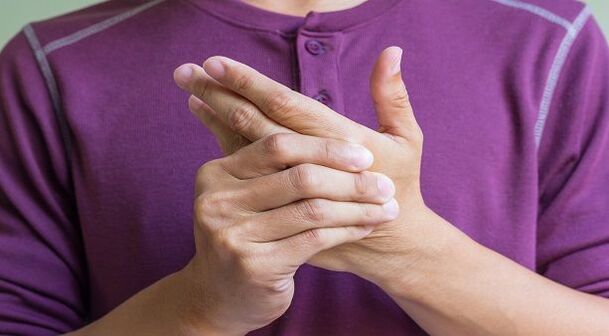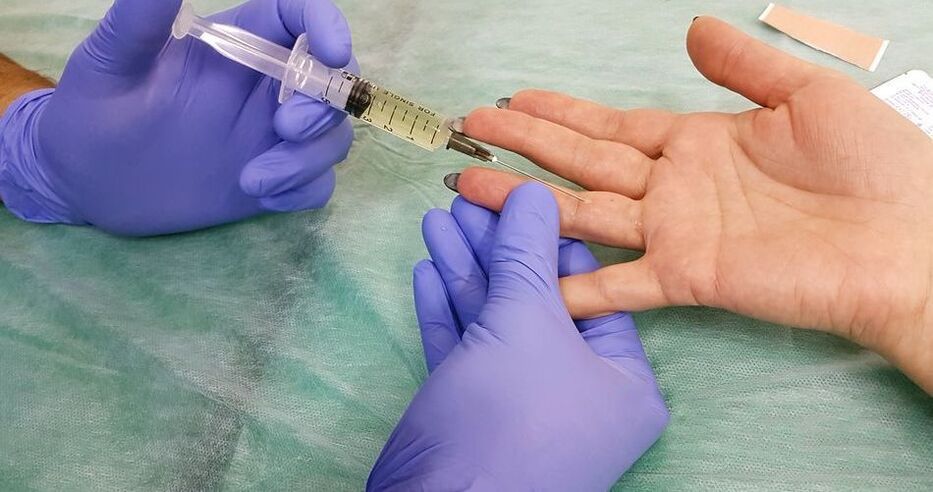Worried about pain in your fingers, and you don't know what's wrong? Perhaps this is the result of trauma, rheumatoid arthritis, polyosteoarthrosis or rhizarthrosis. There are other causes of joint pain that can only be identified with the help of instrumental diagnostics.

Contact the clinic, specialists will establish the clinical picture, conduct complex therapies. With the help of drugs, physiotherapy, rehabilitation methods, inflammation will be eliminated, destructive processes will be stopped, and the limbs will be restored to working capacity.
Why do finger joints hurt: causes and treatment
Joint pain often presents as a sign or symptom of a major disease. Acute sensations arise as a result of inflammatory joint diseases, degenerative-dystrophic pathologies, mainly of traumatic origin. Pain syndrome causes irritation of nerve endings, caused by:
- toxic;
- sodium or potassium urate;
- bone growth;
- Allergens;
- autoimmune processes.
The cause of finger joint pain can be due to a neurological disease or a problem that is not directly related to the limbs. Pain that radiates to the left extremity is a common occurrence during a heart attack. The same goes for problems in the upper part of the cervical region. With a herniated disc, it affects the shoulders, forearms, and hands.
However, there are a number of direct causes that lead to the paralyzed joints, the small joints of the extremities are painful. Finger pain after infection, hypothermia, inflammation of soft tissue and bone structure.
Rheumatoid arthritis
The disease in 7% of cases affects people over the age of 30. It all started with swelling of the sternum-mastoid bones of the leading fingers. Then the catarrhal process spreads to the wrist joint, covering all the structures. It affects one hand, then spreads to the second. A symmetrical lesion of proximal joints with a change in shape is typical for this pathology. For the company, the pelvis, ankle and ankle are affected. Arthritis is characterized by undulating pain. During the first day and midnight they are tolerable, in the middle of the night they intensify and do not allow sleep.
Psoriatic arthritis
It accounts for 5% of cases. The disease affects men and women equally after 20 years. Mostly, it develops in people who have a skin manifestation - psoriatic patches and characteristic spots on the body. Pathology is characterized by "vertical" inflammation with simultaneous thickening of all joints. At the same time, the small point of the finger on the arm is painful, the skin reddens, becomes like a sausage. Unlike rheumatoid arthritis, this process affects both hands, but affects different bones.
Gout
With this problem, less than 5% of patients go to the doctor. It involves men 25-55 years old. The inflammation begins in the big toe, progresses through the joints, affecting the joints of the hands. The pain develops suddenly. It permeates the whole limb, it does not heal for a long time. The affected area becomes purple and hot to the touch. In women, the process is milder, lasting 3-10 days. However, after a while everything repeats itself. A wave-like development is a sign of the development of gout.
Arthritis
By general definition, understanding joint anomalies is of a different nature. They appear as a result of past infections, with systemic diseases. Signs of acute inflammation - swelling, redness, temperature, pain in the knuckles. Often metacarpophalangeal and interphalangeal. In chronic arthritis, the throbbing, intermittent pain is worrisome. Over time, muscles lose strength and function. Finger arthritis leads to physiological loss and disability.
Polyosteoarthrosis
Finger joints on the hand are very painful with degenerative changes in the bones. It all starts with the thinning of cartilage tissue, damage to the pons. The reasons are hidden in the compression and hardening of the synovial membrane, endocrine abnormalities. Doctors consider primary polyarthritis as an independent disease caused by physical overload, hypothermia. Secondary - as a complication after infection and mechanical trauma. In both cases, intense throbbing, muscle spasms occur.
Rhizarthrosis or Osteoarthritis
This is another cause of finger pain, joint pain, and problems at the junction between the thumb and wrist. The process affects the entire joint. This results in:
- to reduce depreciation;
- friction and destruction of each layer of bone tissue;
- thickening in the area between the brains;
- the appearance of nodules and hardening.
- crunch.
One orthopedic surgeon commented:
Symptoms vary depending on the stage. In people who use the thumb for a long time and monotonously, in 30% of cases, rhizoma develops as an independent disease. Since symptoms are 90% consistent with de Quervain's tenosynovitis, the problem is differentiated using radiographs. The images clearly show bone deformities, but not soft tissues such as tendinitis.
onset of finger disease
In medical reference books, trigger finger syndrome is called plantar fasciitis. Symptoms: painful fingers: swelling, lumps, numbness. Characteristically, tendinitis and the formation of nodes impede flexion of the phalanges. In the absence of treatment in stage 3, the finger loses its fixation position, in stage 4 occurs secondary deformity, the process becomes irreversible. Among the many causes of irritation, anatomical anomalies of the ligamentous tendon apparatus are more commonly mentioned.
de Quervain's tenosynovitis
Due to de Quervain's disease, 4% of the bones in the fingers suffer from myositis. Sensation of sensitivity occurs suddenly at the junction of the wrist joint and is aggravated by flexion. Pathology leads to prolonged damage to the synovial membrane of the fingers. The problem is presented by monotonous movements, which, due to constant pressure on the hand and palm, cause skin changes in the ligaments. It:
- play keyboard instruments;
- Printing;
- work on conveyors.
Raynaud's syndrome
Painful fingers due to strong vasoconstriction due to systemic diseases - vasculitis, scleroderma, lupus erythematosus, blood diseases, compression of blood vessels and nerve fibers. Vasospasm with paroxysmal circulatory disorders under the influence of cold temperatures. The clinical syndrome did not appear for many years. Over time, attacks appear that cause the skin to turn cyan, or red, cyan. As a result, the symptoms lead to nutritional changes in the soft tissues.
Carpal tunnel syndrome
Finger joints are also painful due to trauma and the development of carpal tunnel syndrome. An unsuccessful fall or impact can compromise the integrity of tissues and blood vessels, leading to hematoma formation or fracture of the hand. The development of the syndrome is facilitated by compression of the median nerve under the ligament that holds the tendon. Clinical manifestations: palmar numbness, reduced mobility, decreased muscle volume on the large tubercle. Diseases associated with capsulitis are more common in women.
Painful finger bones:
- Because of bursitis in many different forms.
- Childhood malformations - Still's disease, Kawasaki syndrome.
- Systemic disease - diffuse plantar fasciitis, Lyme disease, Sjögren, Crohn's, Bechterev.
- Tumor - myeloma, lymphoblastic leukemia.

Diagnose
It is not possible to determine why the fingers on the hand are sore without a differential examination. First, a visual inspection is performed. The rheumatologist or rheumatologist pays attention to the symmetry of the lesion, symptoms, and other clinical signs. The patient was consulted by a traumatologist and an allergist, and then sent for laboratory tests.
Blood biochemistry determines rheumatoid factor, uric and sialic acid levels, erythrocyte sedimentation rate in the blood. In infectious and immunological diseases, a reactive protein is detected, indicating tissue destruction.
Why do fingers on the hand hurt, causes and treatment for x-ray, ultrasound. The doctor examines the problem structures, conducts a symmetrical diagnosis of a healthy hand. No weight needed:
- to assess the degree of structural damage;
- condition of cartilage and ligaments;
- detect the main signs of anomalies, cysts and nodes.
MRI is prescribed for suspected cases of degenerative disease and cancer. Computed tomography helps to obtain 3D images of soft tissues in different projections, to identify chronic and recent injuries. Informative methods show displacement, width of joint space in arthritis, cartilage thinning in joint disease, bone displacement, growth. Densitometry is sometimes prescribed to determine bone density.
Because of what phalanges of the fingers are damaged, other research methods will be suggested - electromyography and electromyography. The technology first reveals the part of the spine responsible for the movements of the limbs. The second determines the state of peripheral muscles and nerves. When there is a sharp pain in the finger, the specialist may recommend a puncture. Percutaneous aspiration allows you to inhale the bile and inject antibiotics or pain relievers to relieve acute symptoms.
Diagnose
- Ultrasound diagnosis.A non-invasive study is indicated for inflammation and injury of soft tissue, muscles, ligaments, tendons, and joint capsule by ultrasound.
- X-ray.Indications for injuries: dislocations and fractures, joint diseases: osteoarthritis and arthritis.
- Analysis.General blood and urine tests and blood biochemistry revealed signs of inflammation, the presence of infection, and disturbances in bone and cartilage tissues.
- Magnetic resonance imaging.A method of diagnosing joints with high accuracy with information content up to 99%.
Finger pain: causes and treatment
Regardless of the cause, NSAIDs are prescribed to relieve acute sensations, fever, and inflammation. Efficacy: nimesil, phenylbutazone, indomethacin, teraflex, sodium diflofenac. If the knuckles are very painful, ketarolac and tenoxicam are appropriate for treatment. With drip or intramuscular infusion, they eliminate symptoms in 3 days.
Corticosteroid drugs - dexamethasone, prednisolone also reduce the catarrhal process. At the same time, swelling is reduced, cartilage metabolism is improved, contributing to the rapid restoration of mobility. Chondroprotectors thicken the structure of bone tissue, preventing the exacerbation of degenerative processes.
Physiotherapy - ultrasound and pulse therapy, acupuncture improves blood circulation. Exercise therapy helps to develop muscles and restore mobility to joints. Patients should review their diet, implement a diet that is mainly protein and plant foods, and have spa treatments.
Treatments
- Reception of trauma-orthopedic doctors
- Shockwave therapy of the hand
- Plasmolifting the joints
- PRP therapy for the wrist
- Wrist joint blockade
- Injection in brush
- Phonophoresis
- electrophoresis
- Hand ultrasound
- Physical therapy
- Drug treatment
- Orthopedic
- Magnetic therapy
























